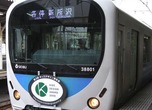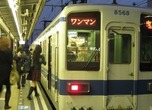
Posted: Fri Aug 13 2010
August is only just getting underway, but summer has already hit its peak force. Day after day, the heat of the sun will probably make you want to head straight for the beach – but sadly there are still a couple of weeks before the Obon holidays start. Want to hit the beach, but don’t have much time? Try some ocean scenery instead; within an hour or two of Tokyo there are some beautiful sea views to be seen from the windows of the trains. Even if you are tight on time and need to stay close to the city centre, you can still get your fill of the seaside.
Enoshima Electric Railway (Enoden), from Inamuragasaki to Koshigoe
Being the closest to Tokyo, the Shonan area in Kanagawa has been the most familiar and frequented beach for Tokyoites for a long time. It’s an hour from the city to Kamakura on the Yokosuka Line, and from there the Enoden Line will take you to Enoshima and Fujisawa. The line runs for around 30 minutes, but it’s the middle section where the ocean will open up before your eyes. Once the train leaves Gokurakuji Station, it will pass through a tunnel in a small hill. The next stop is Inamuragasaki, and from there all the way to Koshigoe Station, the ocean spreads out to your left. You’ll be particularly close to the water at Kamakurakuokou mae Station, through which you will pass on the way, only a single road lies between the train and the sea. After that you’ll move slightly further from the water, and the Enoden actually runs through the streets of Koshigoe. You’ll be able to see dried fish lined up in the storefronts of the fishmongers, along with everything else you’d expect from a town that is a fishing port: all so close you feel like you could reach out and touch it. Until the end of summer it will be possible to sample dishes featuring raw shirasu (baby sardines) in Enoshima.
JR Keiyo Line, from Shiomi to Maihama
For a change of scenery that is particularly convenient to the centre of town, hop on the Keiyo Line for some magnificent views. The train line leaves from an underground level of Tokyo Station, and after travelling below ground to get out of the city centre, the line swoops up to an elevated set of rails. After passing Shiomi Station, on your right you will be able to see the lumberyards which supply the Tokyo construction industry with its timber. Once the canal has been crossed, little by little the scenery will fan out. From Shin-Kiba Station onwards you’ll cross many of the big rivers that flow into Tokyo Bay, such as the Arakawa, Nakagawa and Edogawa. To the right of the train you will be able to see the huge Ferris wheel at the Kasai Seaside Park. If you look further beyond the attractions at the Tokyo Disney Resort, an ocean view from the deepest part of Tokyo Bay unfolds. If you are on thedisney train in the evening, you also might be lucky enough to see the fireworks at Disneyland.
JR Tokaido Line, between Hayakawa and Manazuru
If you get on the Tokaido Line at Tokyo, after about an hour and twenty minutes you’ll reach Odawara Station. It’s a popular sightseeing area and the entrance to Hakone, but you won’t get off just yet. You’ll stay right on the train and continue along by the sea. From the next station, Hayakawa, there is only a narrow piece of land with barely any flat areas; the mountains of Hakone lie to the right, and the Pacific Ocean to the left. Inevitably, the train travels up a mountainside, giving the passengers a look down at the water. By the time the sea starts to only be seen peeking out from between mandarine orchards, you’ll be arriving at Nebukawa Station. The station is built on a steep incline, so the platform is below a cliff, and the station building is above it. What stretches out even further below is the Pacific. From this station it’s even possible to watch the first sunrise over the ocean on New Year’s Day. If you continue on from Nebukawa towards Manazuru you’ll come to the Nebukawa railway bridge straddling the Shiraitogawa, a river flows down from Hakone. As the train is already quite high up, there is an even greater feeling of height on the bridge. It’s not unusual to spot fans taking pictures which capture the mandarin orchards and the iron bridge, the train and the ocean. Incidentally, the orange and green stripes that run along the Tokaido Line trains symbolise the leaves of the mandarin orchards and the colour of the fruit itself.
Izu Kyuko Line, from Izu-Atagawa to Imaihama-Kaigan
Stay on the Tokaido Line for another ten minutes after Nebukawa and then change to the JR Ito Line at Atami and travel for another 20 minutes. Once you arrive at Ito Station you can change to the Izukyu Corporation’s Izu Kyuko Line, which runs southwards down the Izu Peninsula. Once you get this far you’ll start to feel the special, relaxed atmosphere that is so particular to holiday resorts. In about 30 minutes you’ll stop at Izu-Atagawa Station, and once the train moves on, the sea will be laid out to your left. Along the line there are numerous onsen (hot spring) resorts including Ito, Okawa, Hokkawa, Atagawa and Inatori. Regular trains run along the line, but if you can, check the timetable and try to catch the special ‘Resort 21’ train. On one side of the carriage the seats are arranged to face the ocean in a row, like a bench, offering a great view of the sea. What’s more, it’s run as a normal local train, so there is no extra charge. On holidays, the ‘Resort 21’ is run at a rate of about one an hour, and there is also a limited express directly back to Tokyo. The trip to Tokyo takes around two hours.
JR Uchibo Line, from Sanukimachi to Awa-Katsuyama
Tokyo Bay is enclosed by the Miura Peninsula in Kanagawa, and the Boso Peninsula in Chiba. The train line that runs along the Tokyo Bay side of the Boso Peninsula is the Uchibo Line. From Tokyo Station to Chiba Station it takes around 40 minutes, and if you change to the Uchibo Line at Chiba, and travel for another hour, you’ll reach Sanukimachi Station. Then, once you’ve passed through a series of short tunnels, Tokyo Bay will unfold to your right. For some distance the train will travel along with only a single road between you and the water. At Hamakanaya Station along the way, you should take a look to the left, away from the sea. Mt. Nokogiri, with its jagged, saw-like cliff face, will soar above you. The best time to travel through this section is at dusk on a clear day. The great silhouette of Mt. Fuji will float above a golden coloured Tokyo Bay. After the sun has gone down you can see the lights of the fishing boats and enjoy the night view of the Miura Peninsula on the opposite side.
Other stations worth checking out
JR Tsurumi Line, Umi-Shibaura Station
Umi-Shibaura Station is also known for being part of the ‘The 15 minute time warp train’. As the last station on the Tsurumi Line, which leaves from Tsurumi Station on the Keihin-Tohoku Line, it’s not just close to the sea, it’s also on top of it. This ocean area is actually in the middle of the Keihin Industrial Zone, and the train line runs right alongside it.
JR Shin-etsu Main Line, Omigawa Station
It’s pretty far from Tokyo but it’s an amazing location, so we’ve included it in this extra section. Catch the Joetsu Shinkansen, and after an hour and a half you’ll reach Nagaoka Station. Change to the Shin-etsu Main Line and take the train heading towards Toyama for about one hour and you’ll reach Omigawa, a station that directly faces the Sea of Japan. Right beside the station is the beach. If it’s a day with quite a rough sea, the spray from the waves will actually fly onto the platform. With its combination of the beautiful Sea of Japan and the quiet station, this location has appeared as a setting in many films and television drama serials. The sunset is particularly beautiful.
Tweets
- About Us |
- Work for Time Out |
- Send us info |
- Advertising |
- Mobile edition |
- Terms & Conditions |
- Privacy policy |
- Contact Us
Copyright © 2014 Time Out Tokyo














Add your comment